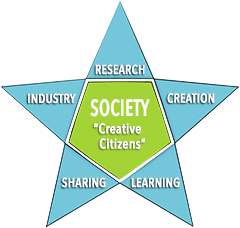WHAT IS EASTN-DC ?
The European Art - Science - Technology Network (EASTN) for Digital Creativity is a project that emerged from several European institutions involved in research, technology development, creation and education in the field of technologies applied to artistic creation.
At European Level, this network is coordinated by ACROE (Grenoble, France) and supported by the Culture Program of the European Union. Since its launch in January 2014, this network has allowed the reception in residence of 40 European artists or collectives, and the creation of many unique pieces.
About digital creativity
Digital art is an artistic work or practice that uses digital technology as an essential part of the creative or presentation process. Since the 1970s, various names have been used to describe the process, including computer art and multimedia art. Digital art is itself placed under the larger umbrella term new media art. Wikipedia
CONCEPT AND OBJECTIVES
EASTN-DC (European Digital Science and Technology Network for Digital Creativity) is a follow-up to EASTN and is a forerunner of the next digital revolution.
After the first phase, known as the "calculating machine", with the intensive development of computing power and its democratization, after the second phase, known as the "communicating machine", with the development of the Internet and large-scale uses, the third phase is in gestation and will be just as revolutionary as the two previous ones.
In this third phase, "machines will address all the sensory and active means of humans", a phase forecast by interactive and multimodal technologies. This phase, in turn, will allow for sensitive creation and communication.
The EASTN-DC project puts forward the idea that it will be possible for the citizen not only to follow this evolution but to anticipate, guide and concentrate it.
- The main objective is the active acculturation of society, reaching out to a wider public
- The second objective, closely linked to the first, is to build capacity - training and education.
Références : Rémy Rieffel "Révolution numérique, révolution culturelle ?" © Éditions Gallimard, 2014.
EASTN-DC METHODOLOGIES
The EASTN-DC project aims to stimulate and support the new and profound emerging paradigm shifts. In order to do so, it proposes to experiment a new methodology in the field of art and culture that closely and agilely links five essential yet separate poles of the transformations inherent to the digital revolution :
Research | Creation | Learning | Sharing | Industry
To counterweight such great disciplinary forces, they must be cross-fertilized, in the very act of creating, whether it be technological creation or artistic creation, or pedagogical creation, or innovations in dissemination or industrial transfer.
Transversality is put forward as an object of experimentation, even as a cultural object.

EASTN-DC concept
EASTN-DC's field of intervention is confined to the digital arts in which the temporal dimension is sought, in musical arts, inteactive visual arts or all performing or interactive arts of any nature.
Experimenting an agile loop between Research | Creation | Learning | Sharing | Industry involves associating the players in each of these divisions closely and innovatively :
researchers and engineers, artists, teachers and educators, cultural broadcasters and the digital industries. The relationship between each of these players is of course cross-examining.
THREE "HOT QUESTIONS"
- The question of rematerialization or "re-tangibility":
Digital has pushed the dematerialization of the processes of creation to the extreme. Today, more and more experiments try to counter this dematerialization by emphasizing processes of re-materialization, or re-tangibility, in order to restore the body its full place in the act of creation. - The question of creation and/or distribution formats :
The formats of work and its presentation to the public pose challenges to the structures, which are not flexible enough to accommodate variable sound spatialization devices, interactive installations, often multi-sensory works, and in relation to an individual or collective work, for a fixed or mobile audience. Constraints generate very partial and often very expensive fallback solutions, and towards the digital whole, thus excluding at the outset certain bodily and/or collective practices. - The question of the relationship to technology :
Technology, Technophilia, Technophobia ?
The current electrical and information technologies are causing highly contradictory postures of technophilia, or of technophobia. These controversies are particularly vivid in the field of artistic creation. Can technology be a positive factor for creativity, either individual and/or collective ?
How ? Why ?
EASTN-ACTIVITIES
The EASTN-DC project proposes to work in the study and experimentation, in full size, of the processes at the borders of the 5 Research | Creation | Learning | Sharing | Industry poles.
It means that a creative activity will question or test its link with research, and/or its link with pedagogy, or with economy, etc. : EASTN-DC will work towards the development of these cross-border approaches, with a view to their formalization as a model until they become a culture.
These concrete actions are of 3 types :
- The development of new creations and content, in an activity identified as :
EASTN-DC "Residence" or "Immersion" - Encounters of these new creations with the public, in an activity identified under the term:
EASTN-DC "Touring" or "Ride" - The shaping of materials, work and contents to ensure their sharing and sustainability, in the activity identified under the term :
EASTN-DC "Communication" or "Ripples".
These three types of activities are not isolated from each other and will involve all partners.
A fourth activity, "Coordination and Administration", supports the cohesion and the synchronous organization of the actions of the project.